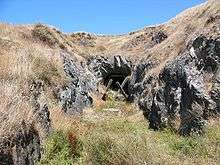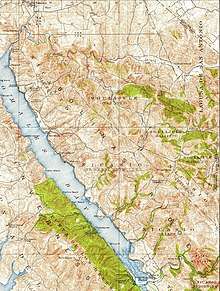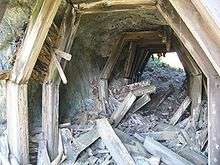North Pacific Coast Railroad
The North Pacific Coast Railroad (NPC) was a common carrier 3 ft (914 mm) narrow-gauge steam railroad begun in 1874 and sold in 1902 to new owners who renamed it the North Shore Railroad (California) (NSR) and which rebuilt the southern section into a standard-gauge electric railway.
| Overview | |
|---|---|
| Headquarters | Sausalito, California |
| Reporting mark | NPC |
| Locale | Marin and Sonoma Counties, California |
| Dates of operation | 1871–1907 |
| Successor | Northwestern Pacific Railroad |
| Technical | |
| Track gauge | 4 ft 8 1⁄2 in (1,435 mm) standard gauge |
| Previous gauge | 3 ft (914 mm) |
The NPC operated in the northern California counties of Marin and Sonoma that carried redwood lumber, local dairy and agricultural products, express and passengers. The NPC operated almost 93 mi (150 km) of track that extended from a pier at Sausalito (which connected the line via ferry to San Francisco) and operated northwest to Duncans Mills and Cazadero (also known as Ingrams). The NPC became the North Shore Railroad (California) (NSR) on March 7, 1902. In 1907 the North Shore Railroad became part of the Northwestern Pacific Railroad (NWP). Southern portions of the line were standard gauged and electrified by the North Shore for suburban passenger service, though tracks north of Point Reyes Station remained 3 ft (914 mm) narrow gauge until abandonment in the late 1930s.
All of the NPC trackage has been abandoned either by the NPC or the NWP. Some of the original right of way can be seen at the Samuel P. Taylor State Park near Fairfax, along the shore of Tomales Bay and Keyes Estuary and passenger depots remain in San Anselmo, Duncans Mills and Point Reyes Station. One NPC steam locomotive, No.12 the "Sonoma," remains as a restored static exhibit in its circa 1870s appearance at the California State Railroad Museum in Sacramento, while Duncans Mills hosts some decaying cars that are not being restored. A flatcar, North Shore 1725, has been restored as a picnic car and operates at the Society for the Preservation of Carter Railroad Resources' Railroad Museum at Ardenwood in Fremont.

Route


Mileposts conform to Southern Pacific Railroad convention of distance from San Francisco:[1]
- San Francisco – Sausalito via Ferry
- Sausalito (milepost 6.5)
- San Rafael
- Junction (later known as San Anselmo) (milepost 16.5)
- Fairfax (milepost 18.3)
- Point Reyes Station (milepost 36.4)
- Marshall (milepost 45.4)
- Tomales (milepost 53.1)
- Valley Ford (milepost 59.5)
- Freestone (milepost 63.7)
- Occidental (milepost 67.6)
- Monte Rio (milepost 73.8)
- Duncans Mills (milepost 77.1)
- Cazadero (milepost 84.3)
Locomotives
| Number | Name | Builder | Type | Date | Works number | Notes[2] |
|---|---|---|---|---|---|---|
| 1 | Saucelito | Baldwin Locomotive Works | 2-6-0 | 1873 | 3495 | sold to White Lumber Company of Elk, California 1876[3] |
| 2 | San Rafael | Mason Machine Works | 0-4-4 T | 1874 | 537 | burned at Tomales 1905 & rebuilt became NWP #89[4] |
| 3 | Tomales | Baldwin Locomotive Works | 4-4-0 | 1875 | 3722 | became NWP #83[5] |
| 4 | Olema | Baldwin Locomotive Works | 4-4-0 | 1874 | 3629 | wrecked 1894 & rebuilt became NWP #81[6] |
| 5 | Bodega | Baldwin Locomotive Works | 4-4-0 | 1875 | 3703 | dismantled by 1897[7] |
| 6 | Valley Ford | Baldwin Locomotive Works | 4-4-0 | 1874 | 3664 | leased to Dollar Lumber Company in 1899[8] |
| 7 | Tamalpais | Baldwin Locomotive Works | 4-4-0 | 1875 | 3721 | [9] |
| 8 | Bully Boy | Mason Machine Works | 0-6-6 T | 1877 | 584 | burned at Tomales 1905[10] |
| 9 | M. S. Latham | Baldwin Locomotive Works | 4-4-0 | 1875 | 3749 | wrecked 14 January 1894 at Elim Grove trestle over Austin Creek[11] |
| 10 | Bloomfield | Baldwin Locomotive Works | 4-4-0 | 1876 | 3840 | sold 1895 Guatemala Western #1 |
| 11 | Marin | Baldwin Locomotive Works | 4-4-0 | 1876 | 3842 | became NWP #82[12] |
| 12 | Sonoma | Baldwin Locomotive Works | 4-4-0 | 1876 | 3843 | sold 1879 Nevada Central #5 (preserved at California State Railroad Museum)[13] |
| 13 | Baldwin Locomotive Works | 2-6-0 | 1883 | 6611 | became NWP #195[14] | |
| 14 | Brooks Locomotive Works | 4-4-0 | 1891 | 1885 | became NWP #92[15] | |
| 15 | Brooks Locomotive Works | 4-4-0 | 1891 | 1886 | became NWP #90[16] | |
| 16 | Brooks Locomotive Works | 4-4-0 | 1894 | 2421 | became NWP #91[17] | |
| 17 | Baldwin Locomotive Works | 4-4-0 | 1875 | 3749 | NPC 1894 rebuild of wreck-damaged #9 wrecked again in 1900[18] | |
| 18 | Brooks Locomotive Works | 4-6-0 | 1899 | 3418 | reputedly the largest 3 ft (914 mm) gauge locomotive in the world when built became NWP #145 then #95[19] | |
| 20 | NPC Sausalito shop | 4-4-0 | 1900 | 1 | became NWP #84[20] | |
| 21 | Thomas-Stetson | NPC Sausalito shop | 4-4-0 | 1901 | 2 | _No_21_at_Howards.jpg) cab-forward rebuild of #5 scrapped 1905[21][22][23][24] |
| 22 | Baldwin Locomotive Works | 4-4-0 | 1874 | 3664 | former #6 renumbered when returned from Dollar Lumber Company in 1901[8] |
Electrification
The NSR was operated by John Martin and Eugene de Sabla Jr., pioneers in the electric railroad business. The southern 23 miles (37 km) of line were modernized to allow operation of standard-gauge electric passenger cars in addition to narrow-gauge steam-powered freight trains. Electric cars sometimes shared dual-gauge tracks with the steam trains, while at other locations a separate track for the electric cars was constructed parallel to the narrow-gauge route. The line was ultimately double tracked from Sausalito to San Anselmo except for the tunnel at Alto. A power house was built at Alto and power was also purchased at San Rafael. Direct current electrical power was transmitted to the trains at 600 volts by a third rail (which was actually a fourth rail on the dual-gauge segments.)[25] Service started to Mill Valley on August 20, 1903, and to San Rafael on October 17, 1903. It was the first United States steam railroad electrified for operational efficiency rather than for smoke abatement. The railroad established practices later used in Grand Central Terminal and the interborough subways of New York City.[26] The electric lines were expanded after 1907 as part of the Northwestern Pacific Railroad. Interurban services ceased on February 28, 1941.[27]
Roster of electric cars
| Number | Builder | Type | Date | Capacity | Notes |
|---|---|---|---|---|---|
| 101-112 | St. Louis Car Co. | Trailers | 1902 | 66 seats | twelve unpowered open platform wooden trailers; #102 built in North Shore shops[28] |
| 201-202 | North Shore shops | Motors | 1904 | 32 seats & baggage/mail/express compartment | two vestibuled wooden motors converted from narrow-gauge Pullman coaches built in 1879[29] |
| 203 | North Shore shops | Motor | 1904 | 50 seats | open platform wooden motor converted from narrow-gauge Pullman coach built in 1879; renumbered 309[28] |
| 301-308 | St. Louis Car Co. | Motors | 1902 | 64 to 70 seats | open platform wooden motors; #303-308 built in North Shore shops[30] |
| 350-358 | St. Louis Car Co. | Motors | 1902 | 36 seats & baggage/mail/express compartment | nine vestibuled wooden motors[29] |
| 401-404 | North Shore shops | Trailers | 1904 | 66 seats | four unpowered open platform wooden trailers converted from narrow-gauge Pullman coaches built in 1879[28] |
References
- Demoro, Harre W. (1983). Electric Railway Pioneer: Commuting on the Northwestern Pacific, 1903-1941. Interurban Press. ISBN 0-916374-55-6.
- Dickinson, A. Bray (1970). Narrow Gauge to the Redwoods. Trans-Anglo Books. ISBN 0-87046-010-2.
- Dickinson, A. Bray (1974). Narrow Gauge to the Redwoods. Trans-Anglo Books. ISBN 0-87046-010-2.
- Kneiss, Gilbert H. (1956). Redwood Railways. Berkeley, California: Howell-North.
- MacGregor, Bruce. Palo Alto (2003). The Birth of California Narrow Gauge. Stanford University Press. ISBN 0-8047-3550-6.
- Stindt, Fred (1974). Trains to the Russian River. Railway and Locomotive Historical Society.
- Stindt, Fred. Kelseyville and Modesto (1982) [1964]. The Northwestern Pacific Railroad: Redwood Empire Route. Dunscomb Press. Library of Congress Catalog No.64-24033.
- Sievers, Wald & Stindt, Fred (1969). N.W.P. Narrow Gauge. The Western Railroader.
Notes
- Stindt (1964) pp.88-89
- Dickinson (1970) pp.132-133
- Dickinson (1974) p.27
- Dickinson (1974) pp.27,72-74,108,110 & 155
- Dickinson (1974) pp.5,63,67,136 & 150
- Dickinson (1974) pp.10,68,87 & 148
- Dickinson (1974) pp.40 & 137
- Kneiss (1956) p.140
- Dickinson (1974) pp.66-67,115 & 134
- Dickinson (1974) pp.50,134 & 156
- Dickinson (1970) pp.46 & 83-83
- Dickinson (1974) pp.88-89
- Dickinson (1974) p.46
- Dickinson (1974) pp.55,80 & 116
- Dickinson (1974) pp.87,109.113,& 136
- Dickinson (1974) pp.76,109 & 137
- Dickinson (1974) p.82
- Dickinson (1974) pp.70,96 & 120
- Dickinson (1974) pp.91 & 155
- Dickinson (1974) pp.2,92,107 & 114
- Dickinson (1974) pp.93-94,115 & 156
- Patented water tube boiler: Patent #682,765, application filed 20 June 1901, patent granted 17 September 1901.
- Patented cab forward: Patent #35,806, application filed 25 November 1901, patent granted 11 March 1902.
- Kyle K Wyatt: Cab Forward Locomotives, 30 November2006.
- Stindt (1964) p.31
- Demoro (1986) pp.13 & 88
- Wood, Jim. "Remnants of the Rail Era". Marin Magazine. December 2016. Retrieved 17 April 2019.
- Stindt (1964) p.214
- Stindt (1964) p.220
- Stindt (1964) p.218